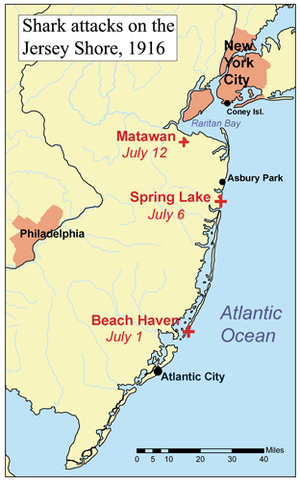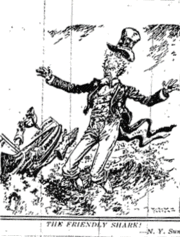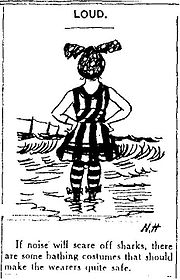- Jersey Shore shark attacks of 1916
-
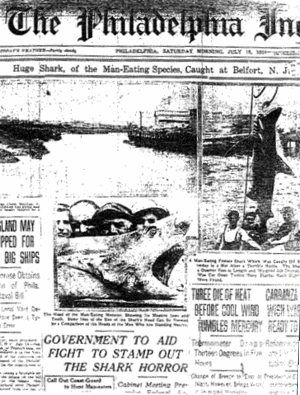 The Philadelphia Inquirer reported the capture of a "man-eating" shark off the Jersey Shore after the attacks.
The Philadelphia Inquirer reported the capture of a "man-eating" shark off the Jersey Shore after the attacks.
The Jersey Shore shark attacks of 1916 were a series of shark attacks along the coast of New Jersey between July 1 and July 12, 1916, in which four people were killed and one injured. Since 1916, scholars have debated which shark species was responsible and the number of animals involved, with the great white shark and the bull shark most frequently being blamed. The attacks occurred during a deadly summer heat wave and polio epidemic in the northeastern United States that drove thousands of people to the seaside resorts of the Jersey Shore. Shark attacks on the Atlantic Coast of the United States outside the semitropical states of Florida, Georgia, and the Carolinas were rare, but scholars believe that the increased presence of sharks and humans in the water led to the attacks in 1916.
Local and national reaction to the attacks involved a wave of panic that led to shark hunts aimed at eradicating the population of "man-eating" sharks and protecting the economies of New Jersey's seaside communities. Resort towns enclosed their public beaches with steel nets to protect swimmers. Scientific knowledge about sharks before 1916 was based on conjecture and speculation. The attacks forced ichthyologists to reassess common beliefs about the abilities of sharks and the nature of shark attacks.
The Jersey Shore attacks immediately entered into American popular culture, where sharks became caricatures in editorial cartoons representing danger. The attacks inspired Peter Benchley's novel Jaws (1974), an account of a great white shark that torments the fictional coastal community of Amity. Jaws was made into an influential film in 1975 by Steven Spielberg. The attacks became the subject of documentaries for the History Channel, National Geographic Channel, and Discovery Channel, including Blood in the Water (2009).
Contents
Attacks and victims
Between July 1 and July 12, 1916, five people were attacked along the coast of New Jersey by sharks; only one of the victims survived. The first attack occurred on Saturday, July 1 at Beach Haven, a resort town established on Long Beach Island off the southern coast of New Jersey. Charles Epting Vansant, 25, of Philadelphia was on vacation at the Engleside Hotel with his family. Before dinner, Vansant decided to take a quick swim in the Atlantic with a Chesapeake Bay Retriever that was playing on the beach. Shortly after entering the water, Vansant began shouting. Bathers believed he was calling to the dog, but a shark was actually biting Vansant's legs. He was rescued by lifeguard Alexander Ott, who claimed the shark followed him to shore as he pulled the bleeding Vansant from the water. Vansant's left thigh was stripped of its flesh; he bled to death on the manager's desk of the Engleside Hotel at 6:45 p.m.[1]
Despite the Vansant incident, beaches along the Jersey Shore remained open. Sightings of large sharks swarming off the coast of New Jersey were reported by sea captains entering the ports of Newark and New York City but were dismissed. The second attack occurred 45 miles (72.4 km) north of Beach Haven at the resort town of Spring Lake, New Jersey. The victim was Charles Bruder, 27, a Swiss bellhop at the Essex & Sussex Hotel. Bruder was killed on Thursday, July 6, 1916, while swimming 130 yards (119 m) from shore. A shark bit him in the abdomen and severed his legs; Bruder's blood turned the water red. After hearing screams, a woman notified a lifeguard that a canoe with a red hull had capsized and was floating just at the water's surface. Lifeguards Chris Anderson and George White rowed to Bruder in a lifeboat and realized he had been bitten by a shark. They pulled him from the water, but he bled to death en route to shore. According to The New York Times, "women [were] panic-stricken [and fainted] as [Bruder's] mutilated body … [was] brought ashore." Guests and workers at the Essex & Sussex and neighboring hotels raised money for Bruder's mother in Switzerland.[2][3]
The next two attacks took place in Matawan Creek near the town of Matawan on Wednesday, July 12. Located 30 miles (48 km) north of Spring Lake and 16 miles (26 km) inland, Matawan resembled a Midwestern town rather than an Atlantic beach resort.[4] Matawan's location made it an unlikely site for shark attacks. When Thomas Cottrell, a sea captain and Matawan resident, spotted an 8 ft (2.44m) long shark in the creek, the town dismissed him.[5] Around 2:00 p.m. local boys, including Lester Stillwell, 11, were playing in the creek at an area called the Wyckoff dock when they saw what appeared to be an "old black weather-beaten board or a weathered log." A dorsal fin appeared in the water and the boys realized it was a shark. Before Stillwell could climb from the creek, the shark attacked him and pulled him underwater.[6]
The boys ran to town for help, and several men, including local businessman Watson Stanley Fisher, 24, came to investigate. Fisher and others dove into the creek to find Stillwell's body, and he was also attacked by the shark in front of the townspeople. Fisher was pulled from the creek without recovering Stillwell's body. His right thigh was severely injured and he bled to death at Monmouth Memorial Hospital in Long Branch at 5:30 p.m.[7] Stillwell's body was recovered 150 feet (46 m) upstream from the Wyckoff dock on July 14.[8]
The fifth and final victim, Joseph Dunn, 12, of New York City was attacked a half mile from the Wyckoff dock nearly 30 minutes after the attacks on Stillwell and Fisher. The shark bit his left leg, but Dunn was rescued by his brother and friend after a vicious tug-of-war battle with the shark. Joseph Dunn was taken to Saint Peter's University Hospital in New Brunswick; he recovered from the attack and was released on September 15, 1916.[9]
Reaction
As the national media descended on Beach Haven, Spring Lake, and Matawan, the Jersey Shore attacks started a shark panic. According to Capuzzo, this panic was "unrivaled in American history," "sweeping along the coasts of New York and New Jersey and spreading by telephone and wireless, letter and postcard."[10] At first, after the Beach Haven attack, scientists and the press reluctantly blamed the death of Charles Vansant on a shark.[11] The New York Times reported that Vansant "was badly bitten in the surf … by a fish, presumably a shark."[12] Still, State Fish Commissioner of Pennsylvania and former director of the Philadelphia Aquarium James M. Meehan asserted in the Philadelphia Public Ledger that the shark was preying on the dog, but attacked Vansant by mistake.[13] He specifically de-emphasized the threat sharks posed to humans:
“ Despite the death of Charles Vansant and the report that two sharks having been caught in that vicinity recently, I do not believe there is any reason why people should hesitate to go in swimming at the beaches for fear of man-eaters. The information in regard to the sharks is indefinite and I hardly believe that Vansant was attacked by a man-eater. Vansant was in the surf playing with a dog and it may be that a small shark had drifted in at high water, and was marooned by the tide. Being unable to move quickly and without food, he had come in to attack the dog and snapped at the man in passing.[14] ” The media's response to the second attack was more sensational. Major American newspapers such as the Boston Herald, Chicago Sun-Times, Philadelphia Inquirer, Washington Post and San Francisco Chronicle placed the story on the front page. The New York Times' headline read, "Shark Kills Bather Off Jersey Beach".[3] The growing panic had cost New Jersey resort owners an estimated $250,000 ($5,000,000 in 2011 dollars) in lost tourism, and bathing had declined 75 percent in some areas.[15] A press conference was convened on July 8, 1916 at the American Museum of Natural History with scientists Frederic Augustus Lucas, John Treadwell Nichols, and Robert Cushman Murphy as panelists. To calm the growing panic, the three men stressed that a third attack was unlikely, although they were admittedly surprised that sharks had attacked at all. Nevertheless, Nichols—the only ichthyologist in the trio—warned swimmers to stay close to shore and to take advantage of the netted bathing areas installed at public beaches after the first attack.[16]
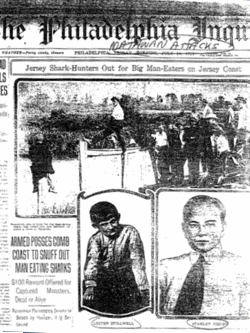 Philadelphia Inquirer coverage of the attacks at Matawan with portraits of Stanley Fisher (bottom right) and Lester Stillwell
Philadelphia Inquirer coverage of the attacks at Matawan with portraits of Stanley Fisher (bottom right) and Lester Stillwell
Shark sightings increased along the Mid-Atlantic Coast following the attacks. On July 8, armed motorboats patrolling the beach at Spring Creek chased an animal they thought to be a shark, and Asbury Park's Asbury Avenue Beach was closed after lifeguard Benjamin Everingham claimed to have beaten off a 12-foot (4 m) long shark with an oar. Sharks were spotted near Bayonne, New Jersey; Rocky Point, New York; Bridgeport, Connecticut; Jacksonville, Florida; and Mobile, Alabama, and a columnist from Field & Stream captured a sandbar shark in the surf at Beach Haven.[17][18] Actress Gertrude Hoffmann was swimming at the Coney Island beach shortly after the Matawan attacks when she claimed to have encountered a shark. The New York Times noted that Hoffman "had the presence of mind to remember that she had read in the Times that a bather can scare away a shark by splashing, and she beat up the water furiously." Hoffman was certain she was going to be devoured by the "Jersey man-eater", but later admitted she was "not sure … whether she had had her trouble for nothing or had barely escaped death."[19][20]
Local New Jersey governments made efforts to protect bathers and the economy from man-eating sharks.[21] The Fourth Avenue Beach at Asbury Park was enclosed with a steel-wire-mesh fence and patrolled by armed motorboats; it remained the only beach open following the Everingham incident. After the attacks on Stillwell, Fisher, and Dunn, residents of Matawan lined Matawan Creek with nets and detonated dynamite in an attempt to catch and kill the shark. Matawan mayor Arris B. Henderson ordered the Matawan Journal to print wanted posters offering a $100 reward ($2,000 in 2011 dollars) to anyone killing a shark in the creek. Despite the town's efforts, no sharks were captured or killed in Matawan Creek.[22] The "Matawan Journal" reported the shark account incident in the front page of its July 13, 1916 issue[23] with another article about the capture of a shark in Keyport a neighboring town in the issue of July 20, 1916.[24]
Resort communities along the Jersey Shore petitioned the federal government to aid local efforts to protect beaches and hunt sharks. The House of Representatives appropriated $5,000 ($100,000 in 2011 dollars) for eradicating the New Jersey shark threat, and President Woodrow Wilson scheduled a meeting with his Cabinet to discuss the attacks. Treasury secretary William Gibbs McAdoo suggested that the Coast Guard be mobilized to patrol the Jersey Shore and protect bathers.[25] Shark hunts ensued across the coasts of New Jersey and New York; as the Atlanta Constitution reported on July 14, "Armed shark hunters in motor boats patrolled the New York and New Jersey coasts today while others lined the beaches in a concerted effort to exterminate the man-eaters … "[26] New Jersey governor James Fairman Fielder and local municipalities offered bounties to individuals hunting sharks.[27] Hundreds of sharks were captured on the East Coast as a result of the attacks. The East Coast shark hunt is described as "the largest scale animal hunt in history."[28]
The attacks on Stilwell then Fisher are also retold in one edition of Irving Wallace's The Book of Lists, in the late 1970s.
Identifying the "Jersey man-eater"
After the second incident, scientists and the public presented theories to explain which species of shark was responsible for the Jersey Shore attacks or whether multiple sharks were involved. Lucas and Nichols proposed that a northward-swimming rogue shark committed the attacks. They believed it would eventually arrive along New York's coast: "Unless the shark came through the Harbor and went through the north through Hell Gate and Long Island Sound, it was presumed it would swim along the South Shore of Long Island and the first deep water inlet it reaches will be the Jamaica Bay."[29]
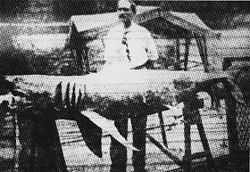 Michael Schleisser and the great white shark caught in Raritan Bay purported to be the "Jersey man-eater" as seen in the Bronx Home News
Michael Schleisser and the great white shark caught in Raritan Bay purported to be the "Jersey man-eater" as seen in the Bronx Home News
Witnesses of the Beach Haven attack estimated that the shark was 9 feet (3 m) long. A sea captain who saw the attack believed it was a Spanish shark driven from the Caribbean Sea decades earlier by bombings during the Spanish-American War.[30] Several fishermen claimed to have caught the "Jersey man-eater" in the days following the attacks. A blue shark was captured on July 14 near Long Branch, and four days later the same Thomas Cottrell who had seen the shark in Matawan Creek claimed to have captured a sandbar shark with a gillnet near the mouth of the creek.[31]
On July 14, Harlem taxidermist and Barnum and Bailey lion tamer Michael Schleisser caught a 7.5 foot (2.3 m), 325 pound (147 kg) shark while fishing in Raritan Bay only a few miles from the mouth of Matawan Creek. The shark nearly sank the boat before Schleisser killed it with a broken oar. When he opened the shark's belly, he removed a "suspicious fleshy material and bones" that took up "about two-thirds of a milk crate" and "together weighed fifteen pounds."[32] Scientists identified the shark as a young great white and the ingested remains as human.[33] Schleisser mounted the shark and placed it on display in the window of a Manhattan shop on Broadway but it was later lost. The only surviving photograph appeared in the Bronx Home News.[34]
No further attacks were reported along the Jersey Shore in the summer of 1916 after the capture of Schleisser's shark. Murphy and Lucas declared the great white to be the "Jersey man-eater".[35] Skeptical individuals, however, offered alternate hypotheses. In a letter to The New York Times, Barrett P. Smith of Sound Beach, New York wrote:
“ Having read with much interest the account of the fatality off Spring Lake, N.J., I should like to offer a suggestion somewhat at variance with the shark theory. In my opinion it is most unlikely that a shark was responsible, and I believe it much more likely that the attack was made by a sea turtle. I have spent much time at sea and along shore, and have several times seen turtles large enough to inflict just such wounds. These creatures are of a vicious disposition, and when annoyed are extremely dangerous to approach, and it is my idea that Bruder may have disturbed one while it was asleep on or close to the surface.[36] ” Another letter to The New York Times blamed the shark infestation on the maneuvers of German U-boats near America's East Coast. The anonymous writer claimed, "These sharks may have devoured human bodies in the waters of the German war zone and followed liners to this coast, or even followed the Deutschland herself, expecting the usual toll of drowning men, women, and children." The writer concluded, "This would account for their boldness and their craving for human flesh."[37]
Decades later, there is no consensus among researchers over Murphy and Lucas's investigation and findings. Richard G. Fernicola published two studies of the event, and notes that "there are many theories behind the New Jersey attacks," and all are inconclusive.[38] Researchers such as Thomas Helm, Harold W. McCormick, Thomas B. Allen, William Young, Jean Campbell Butler, and Michael Capuzzo generally agree with Murphy and Lucas.[39] However, the National Geographic Society reported in 2002 that "some experts are suggesting that the great white may not in fact be responsible for many of the attacks pinned on the species. These people say the real culprit behind many of the reported incidents—including the famous 1916 shark attacks in New Jersey that may have served as inspiration for Jaws—may be the lesser known bull shark."[40]
Biologists George A. Llano and Richard Ellis suggest that a bull shark could have been responsible for the Jersey Shore attacks. Bull sharks swim from the ocean into freshwater rivers and streams and have attacked people around the world. In his book Sharks: Attacks on Man (1975), Llano writes,
“ One of the most surprising aspects of the Matawan Creek attacks was the distance from the open sea. Elsewhere in the book are accounts of well-documented shark attacks at Ahwaz, Iran, which is 90 miles (140 km) upriver from the sea. It may also be of interest to note that sharks live in Lake Nicaragua, a fresh-water body, and in 1944 there was a bounty offered for dead freshwater sharks, as they had "killed and severely injured lake bathers recently."[41] ” Ellis points out that the great white "is an oceanic species, and Schleisser's shark was caught in the ocean. To find it swimming in a tidal creek is, to say the least, unusual, and may even be impossible. The bull shark, however, is infamous for its freshwater meanderings, as well as for its pugnacious and aggressive nature." He admits that "the bull shark is not a common species in New Jersey waters, but it does occur more frequently than the white."[42]
In an interview with Michael Capuzzo, ichthyologist George H. Burgess surmises, "The species involved has always been doubtful and likely will continue to generate spirited debate." Burgess, however, does not discount the great white:
“ The bull draws a lot of votes because the location, Matawan Creek, suggests brackish or fresh waters, a habitat that bulls frequent and whites avoid. However, our examination of the site reveals that the size of the "creek," its depth, and salinity regime were closer to a marine embayment and that a smallish white clearly could have wandered into the area. Since an appropriate sized white shark with human remains in its stomach was captured nearby shortly after the attacks (and no further attacks occurred), it seems likely that this was the attacker involved in at least the Matawan attacks. The temporal and geographical sequence of attacks also suggests that earlier attacks may have involved the same shark.[43] ” The casualties of the 1916 attacks are listed in the International Shark Attack File—of which Burgess is director—as victims of a great white.[44]
The increased presence of humans in the water proved a factor in the attacks: "As the worldwide human population continues to rise year after year, so does … interest in aquatic recreation. The number of shark attacks in any given year or region is highly influenced by the number of people entering the water."[45] However, the likelihood that one shark was involved is contested. Scientists such as Victor M. Coppleson and Jean Butler, relying on evidence presented by Lucas and Murphy in 1916, assert that a single shark was the attacker.[46] On the other hand, Richard Fernicola notes that 1916 was a "shark year" as fishermen and captains were reporting hundreds of sharks swimming in the Mid-Atlantic region of the United States.[47] Ellis remarks that "to try to make the facts as we know them conform to the 'rogue shark' theory is stretching sensationalism and credibility beyond reasonable limits." He admits, "The evidence is long gone, and we will never really know if it was one shark or several, one species or another, that was responsible."[48]
In 2011, further study was conducted in the Smithsonian Channel's The Real Story: Jaws. The documentary takes a closer look at the series of events from different perpectives. It was demonstrated in the Matawan Creek attacks, for example, of how the full moon of the lunar cycle which would have coincided with the attacks would have raised the salinity in the water by more than double just a few hours before high tide. This would have shown support for the theory that a great white could have been responsible. Other evidence such as Joseph Dunn's injury suggested that the type of bite was more likely made by a bull shark as opposed to a great white, leading some to believe more than one shark was likely involved in the five attacks.[49]
Revising science
Before 1916, American scholars doubted that sharks would attack a living person in the temperate waters of the United States without provocation. One skeptical scientist wrote, "There is a great difference between being attacked by a shark and being bitten by one." He believed that sharks tangled in fishing nets or feeding on carrion might accidentally bite a nearby human.[50] In 1891, millionaire banker and adventurer Hermann Oelrichs offered a $500 reward in the New York Sun "for an authenticated case of a man having been attacked by a shark in [the] temperate waters" north of Cape Hatteras, North Carolina.[51] He wanted proof that "in temperate waters even one man, woman, or child, while alive, was ever attacked by a shark."[52] The reward went unclaimed and scientists remained convinced that the eastern coast of the United States was inhabited by harmless sharks.[53][54]
 Leading scientists of the American Museum of Natural History in New York City debated the threat posed by sharks before and after the 1916 Jersey Shore attacks.
Leading scientists of the American Museum of Natural History in New York City debated the threat posed by sharks before and after the 1916 Jersey Shore attacks.
Academics were skeptical that a shark could produce fatal wounds on human victims. Ichthyologist Henry Weed Fowler and curator Henry Skinner of the Academy of Natural Sciences in Philadelphia asserted that a shark's jaws did not have the power to sever a human leg in a single bite.[55] Frederic Lucas, director of the American Museum of Natural History, questioned whether a shark even as large as 30 feet (9 m) could snap a human bone. He told the Philadelphia Inquirer in early 1916 that "it is beyond the power even of the largest Carcharodon to sever the leg of an adult man." Lucas summed up his argument by pointing to Oelrichs's unclaimed reward and that the chances of being attacked by a shark were "infinitely less than that of being struck by lightning and that there is practically no danger of an attack from a shark about our coasts."[56]
The Jersey Shore attacks compelled scientists in the United States to revise their assumptions that sharks were timid and powerless. In July 1916, ichthyologist and editor for the National Geographic Society Hugh McCormick Smith published an article in the Newark Star-Eagle describing some shark species as "harmless as doves and others the incarnation of ferocity." He continued, "One of the most prodigious, and perhaps the most formidable of sharks is the man-eater, Carcharodon carcharias. It roams through all temperate and tropical seas, and everywhere is an object of dread. Its maximum length is forty feet and its teeth are three inches (76 mm) long."[57]
By the end of July 1916, John Nichols and Robert Murphy were taking the great white more seriously. In Scientific American, Murphy wrote that the "white shark is perhaps the rarest of all noteworthy sharks … their habits are little known, but they are said to feed to some extent on big sea turtles … Judging from its physical make-up, it would not hesitate to attack a man in open water." He concluded that "because it is evident that even a relatively small white shark, weighing two or three hundred pounds, might readily snap the largest human bones by a jerk of its body, after it has bitten through the flesh."[58]
Robert Murphy and John Nichols wrote in October 1916:
“ There is something peculiarly sinister in the shark's make-up. The sight of his dark, lean [dorsal] fin lazily cutting zig-zags in the surface of some quiet, sparkling summer sea, and then slipping out of sight not to appear again, suggests an evil spirit. His leering, chinless face, his great mouth with its rows of knife-like teeth, which he knows too well to use on the fisherman's gear; the relentless fury with which, when his last hour has come, he thrashes on deck and snaps at his enemies; his toughness, his brutal, nerveless vitality and insensibility to physical injury, fail to elicit the admiration one feels for the dashing, brilliant, destructive, gastronomic bluefish, tunny, or salmon.[59] ” After the Matawan attacks, Frederic Lucas admitted on the front page of The New York Times that he had underestimated sharks. The paper reported that "the foremost authority on sharks in this country has doubted that any shark ever attacked a human being, and has published his doubts, but the recent cases have changed his view."[20] Nichols later documented the occurrence of the great white shark in his biological survey Fishes of the Vicinity of New York City (1918), "Carcharodon carcharias (Linn.) White Shark. "Man-eater." Accidental in summer. June to July 14, 1916."[60]
Cultural impact
Cartoon from the Philadelphia Evening Bulletin featuring Uncle Sam and a U-boat caricatured as a shark attacks.Cartoon commenting on a Victorian era bathing suit and its ability to frighten sharksWhile sharks had been seen as harmless, the pendulum of public opinion quickly swung to the other extreme, and sharks quickly came to be viewed not only as eating machines, but also as fearless, ruthless killers.
After the first attack, newspaper cartoonists began using sharks as caricatures for political figures, German U-boats, Victorian morality and fashion, polio, and the deadly heat wave threatening the Northeast. Fernicola notes, "Since 1916 was among the years that Americans were trying to break away from the rigidity and conservatism of the Victorian period, one comic depicted a risqué polka-dot bathing suit and advertised it as the secret weapon to keep sharks away from our swimmers." Another cartoon depicted "an exasperated individual at the end of a dock that displays a DANGER: NO SWIMMING sign and mentions the three most emphasized 'danger' topics of the day: 'Infantile Paralysis (polio), Epidemic Heat Wave, and Sharks in the Ocean'." The cartoon is entitled "What's a Family Man to Do?"[61] With America's growing distrust of Germany in 1916, cartoonists depicted U-boats with the mouth and fins of a shark assaulting Uncle Sam while he wades in the water.[62]
In 1974, writer Peter Benchley published Jaws, a novel about a rogue great white shark that terrorizes the fictional coastal community of Amity Island. Chief of police Martin Brody, biologist Matt Hooper, and fisherman Quint hunt the shark after it kills four people. The novel was adapted as the film Jaws by Steven Spielberg in 1975. Spielberg's film makes reference to the attacks: Brody (Roy Scheider) and Hooper (Richard Dreyfuss) urge Amity's Mayor Vaughn (Murray Hamilton) to close the beaches on the Fourth of July after the deaths of two swimmers and a fisherman. Hooper explains to the mayor, "Look, the situation is that apparently a great white shark has staked a claim in the waters off Amity Island. And he's going to continue to feed here as long as there is food in the water." Brody adds, "And there's no limit to what he's gonna do! I mean we've already had three incidents, two people killed inside of a week. And it's gonna happen again, it happened before! The Jersey beach! ... 1916! Five people chewed up on the surf!"[63] Richard Ellis, Richard Fernicola, and Michael Capuzzo suggest that the 1916 Jersey Shore attacks, Coppleson's rogue shark theory, and the exploits of New York fisherman Frank Mundus inspired Benchley.[64] The attacks are also briefly referred to in Benchley's novel White Shark (1994).[65]
The 1916 attacks are the subject of three studies: Richard G. Fernicola's In Search of the "Jersey Man-Eater" (1987) and Twelve Days of Terror (2001) and Michael Capuzzo's Close to Shore (2001). Capuzzo offers an in-depth dramatization of the incident, and Fernicola examines the scientific, medical, and social aspects of the attacks.[66][67] Fernicola's research is the basis of an episode of the History Channel's documentary series In Search of History titled Shark Attack 1916 (2001) and the Discovery Channel's docudrama 12 Days of Terror (2004).[68][69] Fernicola also wrote and directed a 90-minute documentary called Tracking the Jersey Man-Eater. It was produced by the George Marine Library in 1991; however, it was never widely released.[70]
In 2008, Shore Thing, a short fictional film inspired by the attacks, directed by Lovari and James Hill was released and appeared in several U.S. film festivals. In December 2009, it received an award for Best Suspense Short at the NY International Independent Film & Video Festival.
In 2009, Discovery Channel's Shark Week had a two-hour documentary about all the attacks and the days after, titled Blood in the Water. The attacks at Matawan are the subject of the National Geographic Channel documentary Attacks of the Mystery Shark (2002), which examines the possibility that a bull shark was responsible for killing Stanley Fisher and Lester Stillwell.[40]
In 2011, Smithsonian Channel's The Real Story: Jaws examines the series of events in detail and explores the varying perspectives.[49]
Experimental progressive post-metal band Giant Squid based their 2005 album "Monster in the Creek" on the attacks and the cover art featured a photo of the Matawan creek.
See also
- List of fatal, unprovoked shark attacks in the United States by decade
References
- ^ Fernicola, Twelve Days of Terror, pp. 1–9; Capuzzo, Close to Shore, pp. 88–103; Thomas B. Allen, Shadows in the Sea: The Sharks, Skates, and Rays, (1963; Guilford, Conn.: The Lyons Press, 1996), pp. 3–4, ISBN 1-55821-518-2.
- ^ Fernicola, Twelve Days of Terror, pp. 13–21, 29; Capuzzo, Close to Shore, pp. 136–146; Allen, Shadows in the Sea, pp. 4–6.
- ^ a b "Shark Kills Bather Off Jersey Beach. Bites Off Both Legs of a Youth Swimming Beyond Spring Lake Life Lines. Guards Find Him Dying. Women Are Panic-Stricken as Mutilated Body of Hotel Employee Is Brought Ashore." (PDF). The New York Times. July 7, 1916. http://query.nytimes.com/mem/archive-free/pdf?res=9F04E1DB173BE633A25754C0A9619C946796D6CF. Retrieved 2007-08-21. "Hundreds of men and women and many children were on the beach this afternoon when a swimmer, far out beyond the outer life lines, raised a cry for help. George White and Chris Anderson, life guards, who had been watching the swimmer closely because of his distance from shore, launched a lifeboat and started for him while the crowd on the beach watched in suspense and fear."
- ^ Fernicola, Twelve Days of Terror, pp. 33–34.
- ^ Fernicola, Twelve Days of Terror, p. 45.
- ^ Fernicola, Twelve Days of Terror, pp. 45–50.
- ^ Fernicola, Twelve Days of Terror, pp. 45–56.
- ^ Fernicola, Twelve Days of Terror, pp. 83–84; Capuzzo, Close to Shore, pp. 205–248; Allen, Shadows in the Sea, pp. 8–12.
- ^ Fernicola, Twelve Days of Terror, pp. 56–57, 158, 176; Allen, Shadows in the Sea, p. 12, lists Dunn as 14, not 12; The New York Times reported his age at 12 ("Shark Kills 2 Bathers, Maims 1, Near New York," July 13, 1916, p. 1); see also Joseph Dunn's census and hospital records for his age at the time of the attacks; last accessed September 1, 2007.
- ^ Capuzzo, Close to Shore, p. 269.
- ^ Fernicola, Twelve Days of Terror, p. 9.
- ^ "Dies After Attack By Fish," The New York Times, July 3, 1916, p. 18.
- ^ Fernicola, Twelve Days of Terror, pp. 7–11.
- ^ "Bathers Need Have No Fear of Sharks: Lousy Fish Expert Declares One That Killed Swimmer May Have Sought To Attack Dog," Philadelphia Public Ledger, quoted in Fernicola, Twelve Days of Terror, pp. 9–10.
- ^ Allen, Shadows in the Sea, p. 7.
- ^ Fernicola, Twelve Days of Terror, pp. 22–23.
- ^ "Motor Boats Hunt Man-Eating Sharks Off Jersey Coast," Atlanta Constitution, July 14, 1916, p. 3.
- ^ Fernicola, Twelve Days of Terror, p. 26–27.
- ^ Capuzzo, Close to Shore, p. 267–269.
- ^ a b "Many See Sharks, But All Get Away. Matawan's Population, With Weapons And Dynamite, Seek Man-Eater That Killed Two. Science Admits Its Error. No Longer Doubted That Big Fish Attack Men. New Theories As To Why Coast Is Now Infested." (PDF). New York Times. July 14, 1916, Friday. http://query.nytimes.com/mem/archive-free/pdf?res=9502E1DE1E3FE233A25757C1A9619C946796D6CF. Retrieved 2007-08-21. "Matawan Creek, the little stream in which two swimmers were killed by a shark and another severely bitten on Wednesday, was alive with sharks yesterday, according to the scores of men who went out to hunt them with rifles, shotguns, boat hooks, harpoons, pikes, and dynamite."
- ^ "Shark Guards Out At Beach Resorts; Wire Nets Set Against Supposed Man-Eater That Killed Spring Lake Bather," The New York Times, July 8, 1916, p. 18.
- ^ Fernicola, Twelve Days of Terror, p. 67.
- ^ http://173.12.11.248/DATA/1900-24/1916/1916-07-13.pdf
- ^ http://173.12.11.248/DATA/1900-24/1916/1916-07-20.pdf
- ^ Fernicola, Twelve Days of Terror, pp. 67–70.
- ^ "Motor Boats Hunt Man-Eating Sharks Off Jersey Coast," Atlanta Constitution, p. 1.
- ^ Fernicola, Twelve Days of Terror, p. 81.
- ^ Fernicola, Twelve Days of Terror, p. 72.
- ^ Nichols in the New York American, quoted in Fernicola, Twelve Days of Terror, p. 151.
- ^ Fernicola, Twelve Days of Terror, p. 7–8.
- ^ Fernicola, Twelve Days of Terror, pp. 144–145.
- ^ Fernicola, Twelve Days of Terror, p. 151–156.
- ^ Fernicola, Twelve Days of Terror, p. 163.
- ^ Fernicola, Twelve Days of Terror, pp. 163–164.
- ^ Capuzzo, Close to Shore, pp. 296–297; Fernicola, Twelve Days of Terror, p. 179.
- ^ Barrett P. Smith, "Perhaps It Was a Turtle," The New York Times, July 14, 1916, p. 10.
- ^ A. M. E., "Sharks and Submarines," The New York Times, July 15, 1916, p. 8.
- ^ Fernicola, Twelve Days of Terror, p. 184.
- ^ Thomas Helm, Shark!: Unpredictable Killer of the Sea (New York: Dodd, Mead, 1962), OCLC 1521199; Harold W. McCormick, Thomas B. Allen, and William Young, Shadows in the Sea: The Sharks, Skates, and Rays (Philadelphia: Chilton Books, 1963), OCLC 965044; Jean Campbell Butler, Danger, Shark! (Boston: Little, Brown, 1964), OCLC 1392203; for a summary of these researchers' findings, see Fernicola, Twelve Days of Terror, pp. 179–180.
- ^ a b Brian Handwerk, "Great Whites May Be Taking the Rap for Bull Shark Attacks," August 2, 2002, National Geographic News; last accessed July 29, 2007.
- ^ George A. Llano, Sharks: Attacks on Man (New York: Tempo Books, 1975), pp. 57–58, ISBN 0-448-12217-0.
- ^ Richard Ellis, The Book of Sharks (San Diego: Harcourt Brace Jovanovich, 1983), p. 186, ISBN 0-15-613552-3.
- ^ George H. Burgess, interview with Michael Capuzzo, n.d., available at Random House.com; last accessed July 28, 2007.
- ^ See the graphic map, "1916–2006 United States (incl. Hawaii) Confirmed Unprovoked Attacks by White Sharks", International Shark Attack File; last accessed July 28, 2007.
- ^ George Burgess, "The Relative Risk of Shark Attacks to Humans: More People Mean More Attacks," International Shark Attack File; last accessed July 31, 2007.
- ^ Victor M. Coppleson, Shark Attack (Sydney: Angus & Robertson, 1959) OCLC 1547643, and Butler, Danger, Shark!, both cited in Fernicola, Twelve Days of Terror, p. 248.
- ^ Fernicola, Twelve Days of Terror, pp. 229–231.
- ^ Ellis, Book of Sharks, p. 187.
- ^ a b The Real Story: Jaws (Smithsonian Channel, 2011); last accessed May 31, 2011.
- ^ Frederic Lucas, quoted in Fernicola, Twelve Days of Terror, p. xxix.
- ^ Hermann Oelrichs, quoted in Fernicola, Twelve Days of Terror, p. xxv.
- ^ Oelrichs, quoted in Capuzzo, Close to Shore, p. 22.
- ^ Fernicola, Twelve Days of Terror, xxv.
- ^ Capuzzo, Close to Shore, p. 26.
- ^ Fernicola, Twelve Days of Terror, pp. xxvi–xxviii.
- ^ Frederic Lucas, quoted in Fernicola, Twelve Days of Terror, p. xxx.
- ^ Hugh M. Smith, "Great Shark May Have Swallowed Jonah: Scientist Shows Biblical 'Great Fish' Has Counterpart in Present-Day Monster," Newark Star-Eagle, quoted in Fernicola, Twelve Days of Terror, p. 160.
- ^ Murphy, Scientific American, July 1916, quoted in Fernicola, Twelve Days of Terror, 171.
- ^ Murphy and Nichols, Brooklyn Museum Science Bulletin, quoted in Capuzzo, Close to Shore, p. 285.
- ^ John T. Nichols, Fishes of the Vicinity of New York City, (New York: American Museum of Natural History, 1918), p. 101. See full text at the Biodiversity Heritage Library.
- ^ Fernicola, Twelve Days of Terror, p. 27.
- ^ Fernicola, Twelve Days of Terror, p. 33.
- ^ Jaws, dir. Steven Spielberg (Universal Pictures, 1975).
- ^ Ellis, Book of Sharks, p. 209; Fernicola, Twelve Days of Terror, p. 180; Capuzzo, Close to Shore, p. 297.
- ^ Peter Benchley, White Shark (New York: St. Martin's, 1994), p. 51, ISBN 0-312-95573-1.
- ^ Adam Dunn, "Review: A biting history on the roots of 'Jaws'," review of Close to Shore, CNN.com; last accessed July 28, 2007.
- ^ Lane Hartill, "My, what nice teeth you have," The Christian Science Monitor, June 21, 2001, p. 16.
- ^ Shark Attack 1916, dir. David Ackroyd, In Search of ... (A&E Television, 2001).
- ^ 12 Days of Terror, dir. Jack Sholder (Discovery Fox Television, 2004).
- ^ Tracking the Jersey Man-Eater, dir. Richard G. Fernicola (George Marine Library, 1991).
Further reading
- Capuzzo, Michael. "Close to Shore: A True Story of Terror in an Age of Innocence". New York, N.Y. Random House Inc, 2001. ISBN 0-767-90413-1.
- Fernicola, Richard G. In Search of the "Jersey Man-Eater": An Exhaustive Investigation of the Infamous Shark Attacks that Plagued the New Jersey Shore during the Summer of 1916. Deal, N.J.: George Marine Library, 1986. OCLC 16678080
- Fleming, Thomas J. New Jersey: A History. New York: W. W. Norton, 1984. ISBN 0-393-30180-X.
- Genovese, Peter. The Jersey Shore Uncovered: A Revealing Season on the Beach. New Brunswick, N.J.: Rutgers University Press, 2003. ISBN 0-8135-3315-5.
- Henderson, Helen. Matawan and Aberdeen: Of Town and Field. Charleston, S.C.: Arcadia Publishing, 2003. ISBN 0-7385-2403-4.
- May, Nathaniel. Shark: Stories of Life and Death from the World's Most Dangerous Waters. New York: Thunder's Mouth Press, 2002. ISBN 1-56025-397-5.
- Nichols, John T. Fishes of the vicinity of New York city, by John Treadwell Nichols, with an introduction by William K. Gregory. New York, Printed at the Museum, 1918. http://www.biodiversitylibrary.org/bibliography/1951.
- Stansfield, Charles A., Jr. Vacationing on the Jersey Shore: The Past and Present, with a Guide to the Beach Resorts. Mechanicsburg, Penn.: Stackpole Books, 2004. ISBN 0-8117-2970-2.
External links
Listen to this article (info/dl)
This audio file was created from a revision of Jersey Shore shark attacks of 1916 dated 2007-09-06, and does not reflect subsequent edits to the article. (Audio help)More spoken articlesCategories:- 1916 in New Jersey
- Deaths due to shark attacks
- Deaths due to animal attacks in the United States
- History of New Jersey
- History of the United States (1865–1918)
- Monmouth County, New Jersey
- Ocean County, New Jersey
- History of biology
- Accidental deaths in New Jersey
- Man-eaters
- Jaws (franchise)
Wikimedia Foundation. 2010.

